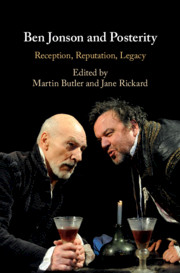33 results
Part II - Jonson’s Early Reception
-
- Book:
- Ben Jonson and Posterity
- Published online:
- 24 September 2020
- Print publication:
- 08 October 2020, pp 83-146
-
- Chapter
- Export citation
Copyright page
-
- Book:
- Ben Jonson and Posterity
- Published online:
- 24 September 2020
- Print publication:
- 08 October 2020, pp iv-iv
-
- Chapter
- Export citation
Contents
-
- Book:
- Ben Jonson and Posterity
- Published online:
- 24 September 2020
- Print publication:
- 08 October 2020, pp vii-viii
-
- Chapter
- Export citation
Acknowledgements
-
- Book:
- Ben Jonson and Posterity
- Published online:
- 24 September 2020
- Print publication:
- 08 October 2020, pp xiv-xiv
-
- Chapter
- Export citation
Part I - Conceptualizing Jonson
-
- Book:
- Ben Jonson and Posterity
- Published online:
- 24 September 2020
- Print publication:
- 08 October 2020, pp 23-82
-
- Chapter
- Export citation
Dedication
-
- Book:
- Ben Jonson and Posterity
- Published online:
- 24 September 2020
- Print publication:
- 08 October 2020, pp v-vi
-
- Chapter
- Export citation
Part III - Jonsonian Afterlives
-
- Book:
- Ben Jonson and Posterity
- Published online:
- 24 September 2020
- Print publication:
- 08 October 2020, pp 147-250
-
- Chapter
- Export citation
Contributors
-
- Book:
- Ben Jonson and Posterity
- Published online:
- 24 September 2020
- Print publication:
- 08 October 2020, pp xi-xiii
-
- Chapter
- Export citation
Chapter 4 - Seventeenth-Century Readers of Jonson’s 1616 Works
- from Part II - Jonson’s Early Reception
-
-
- Book:
- Ben Jonson and Posterity
- Published online:
- 24 September 2020
- Print publication:
- 08 October 2020, pp 85-104
-
- Chapter
- Export citation
Index
-
- Book:
- Ben Jonson and Posterity
- Published online:
- 24 September 2020
- Print publication:
- 08 October 2020, pp 251-256
-
- Chapter
- Export citation
Figures
-
- Book:
- Ben Jonson and Posterity
- Published online:
- 24 September 2020
- Print publication:
- 08 October 2020, pp ix-x
-
- Chapter
- Export citation
Citations and Abbreviations
-
- Book:
- Ben Jonson and Posterity
- Published online:
- 24 September 2020
- Print publication:
- 08 October 2020, pp xv-xvi
-
- Chapter
- Export citation
Introduction: Immortal Ben Jonson
-
-
- Book:
- Ben Jonson and Posterity
- Published online:
- 24 September 2020
- Print publication:
- 08 October 2020, pp 1-22
-
- Chapter
- Export citation

Ben Jonson and Posterity
- Reception, Reputation, Legacy
-
- Published online:
- 24 September 2020
- Print publication:
- 08 October 2020
Part III - James, Shakespeare and the Jacobean Theatre
-
- Book:
- Writing the Monarch in Jacobean England
- Published online:
- 05 October 2015
- Print publication:
- 08 October 2015, pp 207-259
-
- Chapter
- Export citation
Glossary
-
- Book:
- Writing the Monarch in Jacobean England
- Published online:
- 05 October 2015
- Print publication:
- 08 October 2015, pp x-x
-
- Chapter
- Export citation
Part I - James, Jonson and the Jacobean Court
-
- Book:
- Writing the Monarch in Jacobean England
- Published online:
- 05 October 2015
- Print publication:
- 08 October 2015, pp 57-134
-
- Chapter
- Export citation
Copyright page
-
- Book:
- Writing the Monarch in Jacobean England
- Published online:
- 05 October 2015
- Print publication:
- 08 October 2015, pp iv-iv
-
- Chapter
- Export citation
Introduction
-
- Book:
- Writing the Monarch in Jacobean England
- Published online:
- 05 October 2015
- Print publication:
- 08 October 2015, pp 1-56
-
- Chapter
- Export citation
Part II - James, Donne and the Politics of Religion in Jacobean England
-
- Book:
- Writing the Monarch in Jacobean England
- Published online:
- 05 October 2015
- Print publication:
- 08 October 2015, pp 135-206
-
- Chapter
- Export citation

